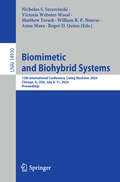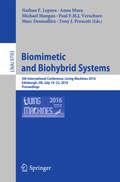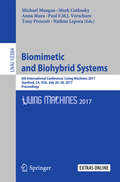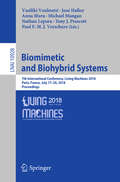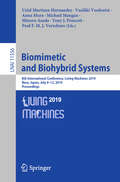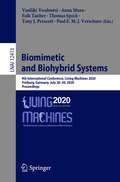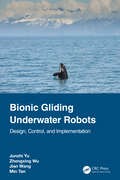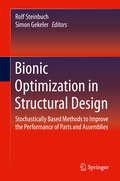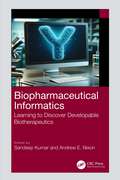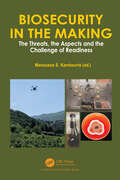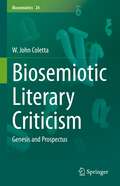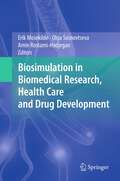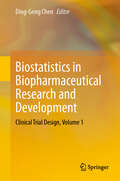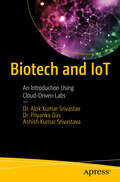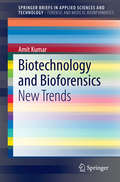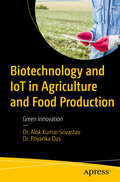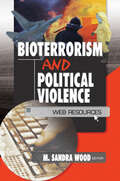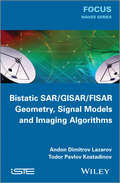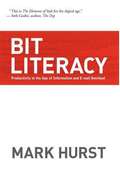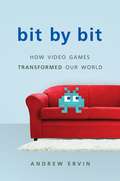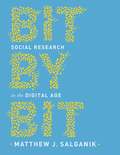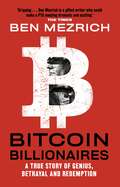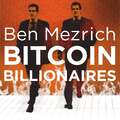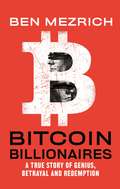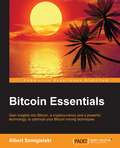- Table View
- List View
Biomimetic and Biohybrid Systems: 13th International Conference, Living Machines 2024, Chicago, IL, USA, July 8–11, 2024, Proceedings (Lecture Notes in Computer Science #14930)
by Anna Mura Nicholas S. Szczecinski Victoria Webster-Wood Matthew Tresch William R. P. Nourse Roger D. QuinnThis proceeding constitutes the 13th International Conference on Biomimetic and Biohybrid Systems, held in Chicago, IL, USA, during July 8–11, 2024. The 27 full papers and 4 short papers were carefully reviewed and selected from 35 submissions. They were categorized under the following topics: Brain Network Modeling; Tools for Studying Behaviors; Sensors and Sensing, Navigational Systems; Control and Mechanics of Soft and Continuum Systems; System Design; Neural Networks for Computation; Bio Inspired Neural Networks for Control; Biohybrid Systems; and Biomechanics.
Biomimetic and Biohybrid Systems: 5th International Conference, Living Machines 2016, Edinburgh, UK, July 19-22, 2016. Proceedings (Lecture Notes in Computer Science #9793)
by Tony J. Prescott Michael Mangan Nathan F. Lepora Anna Mura Paul F.M.J. Verschure Marc DesmulliezThis book constitutes the refereed proceedings of the second International Conference on Biomimetic and Biohybrid Systems, Living Machines 2013, held in London, UK, in July/August 2013. The 65 revised full papers presented were carefully reviewed and selected from various submissions. The papers are targeted at the intersection of research on novel live-like technologies inspired by scientific investigation of biological systems, biomimetics, and research that seeks to interface biological and artificial systems to create biohybrid systems
Biomimetic and Biohybrid Systems: 6th International Conference, Living Machines 2017, Stanford, CA, USA, July 26–28, 2017, Proceedings (Lecture Notes in Computer Science #10384)
by Michael Mangan, Mark Cutkosky, Anna Mura, Paul F.M.J. Verschure, Tony Prescott and Nathan LeporaThis book constitutes the proceedings of the 6th International Conference on Biomimetic and Biohybrid Systems, Living Machines 2017, held in Stanford, CA, USA, in July 2017.The 42 full and 19 short papers presented in this volume were carefully reviewed and selected from 63 submissions. The theme of the conference encompasses biomimetic methods for manufacture, repair and recycling inspired by natural processes such as reproduction, digestion, morphogenesis and metamorphosis.
Biomimetic and Biohybrid Systems: 7th International Conference, Living Machines 2018, Paris, France, July 17–20, 2018, Proceedings (Lecture Notes in Computer Science #10928)
by Tony J. Prescott Michael Mangan Anna Mura Paul F.M.J. Verschure Nathan Lepora Vasiliki Vouloutsi José HalloyThis book constitutes the proceedings of the 7th International Conference on Biomimetic and Biohybrid Systems, Living Machines 2018, held in Paris, France, in July 2018.The 40 full and 18 short papers presented in this volume were carefully reviewed and selected from 60 submissions. The theme of the conference targeted at the intersection of research on novel life-like technologies inspired by the scientific investigation of biological systems, biomimetics, and research that seeks to interface biological and artificial systems to create biohybrid systems.
Biomimetic and Biohybrid Systems: 8th International Conference, Living Machines 2019, Nara, Japan, July 9–12, 2019, Proceedings (Lecture Notes in Computer Science #11556)
by Tony J. Prescott Michael Mangan Minoru Asada Anna Mura Vasiliki Vouloutsi Uriel Martinez-Hernandez Paul F. M. J. VerschureThis book constitutes the proceedings of the 8th International Conference on Biomimetic and Biohybrid Systems, Living Machines 2019, held in Nara, Japan, in July 2019. The 26 full and 16 short papers presented in this volume were carefully reviewed and selected from 45 submissions. They deal with research on novel life-like technologies inspired by the scientific investigation of biological systems, biomimetics, and research that seeks to interface biological and artificial systems to create biohybrid systems.
Biomimetic and Biohybrid Systems: 9th International Conference, Living Machines 2020, Freiburg, Germany, July 28–30, 2020, Proceedings (Lecture Notes in Computer Science #12413)
by Tony J. Prescott Anna Mura Thomas Speck Vasiliki Vouloutsi Paul F. M. J. Verschure Falk TauberThis book constitutes the proceedings of the )th International Conference on Biomimetic and Biohybrid Systems, Living Machines 2020, held in Freiburg, Germany, in July 2020. Due to COVID-19 pandemic the conference was held virtually. The 32 full and 7 short papers presented in this volume were carefully reviewed and selected from 45 submissions. They deal with research on novel life-like technologies inspired by the scientific investigation of biological systems, biomimetics, and research that seeks to interface biological and artificial systems to create biohybrid systems.
Bionic Gliding Underwater Robots: Design, Control, and Implementation
by Jian Wang Junzhi Yu Min Tan Zhengxing WuUnderwater robots play a significant role in ocean exploration. This book provides full coverage of the theoretical and practical aspects of bionic gliding underwater robots, including system design, modeling control, and motion planning. To overcome the inherent shortcomings of traditional underwater robots that can simultaneously lack maneuverability and endurance, a new type of robot, the bionic gliding underwater robot, has attracted much attention from scientists and engineers. On the one hand, by imitating the appearance and swimming mechanisms of natural creatures, bionic gliding underwater robots achieve high maneuverability, swimming efficiency, and strong concealment. On the other hand, borrowing from the buoyancy adjustment systems of underwater gliders, bionic gliding underwater robots can obtain strong endurance, which is significant in practical applications. Taking gliding robotic dolphin and fish as examples, the designed prototypes and proposed methods are discussed, offering valuable insights into the development of next-generation underwater robots that are well suited for various oceanic applications. This book will be of great interest to students and professionals alike in the field of robotics or intelligent control. It will also be a great reference for engineers or technicians who deal with the development of underwater robots.
Bionic Optimization in Structural Design: Stochastically Based Methods to Improve the Performance of Parts and Assemblies
by Rolf Steinbuch Simon GekelerThe book provides suggestions on how to start using bionic optimization methods, including pseudo-code examples of each of the important approaches and outlines of how to improve them. The most efficient methods for accelerating the studies are discussed. These include the selection of size and generations of a study's parameters, modification of these driving parameters, switching to gradient methods when approaching local maxima, and the use of parallel working hardware. Bionic Optimization means finding the best solution to a problem using methods found in nature. As Evolutionary Strategies and Particle Swarm Optimization seem to be the most important methods for structural optimization, we primarily focus on them. Other methods such as neural nets or ant colonies are more suited to control or process studies, so their basic ideas are outlined in order to motivate readers to start using them. A set of sample applications shows how Bionic Optimization works in practice. From academic studies on simple frames made of rods to earthquake-resistant buildings, readers follow the lessons learned, difficulties encountered and effective strategies for overcoming them. For the problem of tuned mass dampers, which play an important role in dynamic control, changing the goal and restrictions paves the way for Multi-Objective-Optimization. As most structural designers today use commercial software such as FE-Codes or CAE systems with integrated simulation modules, ways of integrating Bionic Optimization into these software packages are outlined and examples of typical systems and typical optimization approaches are presented. The closing section focuses on an overview and outlook on reliable and robust as well as on Multi-Objective-Optimization, including discussions of current and upcoming research topics in the field concerning a unified theory for handling stochastic design processes.
Biopharmaceutical Informatics: Learning to Discover Developable Biotherapeutics
by Sandeep Kumar Andrew E. NixonDespite the phenomenal clinical success of antibody-based biopharmaceuticals in recent years, discovery and development of these novel biomedicines remains a costly, time-consuming, and risky endeavor with low probability of success. To bring better biomedicines to patients faster, we have come up with a strategic vision of Biopharmaceutical Informatics which calls for syncretic use of computation and experiment at all stages of biologic drug discovery and pre-clinical development cycles to improve probability of successful clinical outcomes. Biopharmaceutical Informatics also encourages industry and academic scientists supporting various aspects of biotherapeutic drug discovery and development cycles to learn from our collective experiences of successes and, more importantly, failures. The insights gained from such learnings shall help us improve the rate of successful translation of drug discoveries into drug products available to clinicians and patients, reduce costs, and increase the speed of biologic drug discovery and development. Hopefully, the efficiencies gained from implementing such insights shall make novel biomedicines more affordable for patients.This unique volume describes ways to invent and commercialize biomedicines more efficiently: Calls for digital transformation of biopharmaceutical industry by appropriately collecting, curating, and making available discovery and pre-clinical development project data using FAIR principles Describes applications of artificial intelligence and machine learning (AIML) in discovery of antibodies in silico (DAbI) starting with antigen design, constructing inherently developable antibody libraries, finding hits, identifying lead candidates, and optimizing them Details applications of AIML, physics-based computational design methods, and other bioinformatics tools in fields such as developability assessments, formulation and excipient design, analytical and bioprocess development, and pharmacology Presents pharmacokinetics/pharmacodynamics (PK/PD) and Quantitative Systems Pharmacology (QSP) models for biopharmaceuticals Describes uses of AIML in bispecific and multi-specific formats Dr Sandeep Kumar has also edited a collection of articles dedicated to this topic which can be found in the Taylor and Francis journal mAbs.
Biosecurity in the Making: The Threats, the Aspects and the Challenge of Readiness
by Manousos E. KambourisThe explosive growth of bioeconomy and bioscience, coupled with an interconnected planet increases the potential impact of large-scale bio-events. Either causing public health threats as in epidemics or posing food security issues, from mass poisonings to large-scale starvation, such eventualities are direct threats and indirect destabilizers in a planetary context. The issue of Biosecurity thus pervades every affected aspect, from exploitations of the agro-sector and the food industry to the Public Health management, the novel therapeutic/treatment approaches, the new age of space, deep-sea and subterranean explorations and the interface with the cyber world and the massive or small-scale projection of violence. It has been present since ancient times tacitly and discreetly but only recently took its present guise, the different aspects of which are explored in this book.
Biosemiotic Literary Criticism: Genesis and Prospectus (Biosemiotics #24)
by W. John ColettaThis volume is based to a large extent on the understanding of biosemiotic literary criticism as a semiotic-model-making enterprise. For Jurij Lotman and Thomas A. Sebeok, “nature writing is essentially a model of the relationship between humans and nature” (Timo Maran); biosemiotic literary criticism, itself a form of nature writing and thus itself an ecological-niche-making enterprise, will be considered to be a model of modeling, a model of nature naturing. Modes and models of analysis drawn from Thomas A. Sebeok and Marcel Danesi’s Forms of Meaning: Modeling Systems Theory and Semiotic Analysis as well as from Timo Maran’s work on “modeling the environment in literature,” Edwina Taborsky’s writing on Peircean semiosis, and, of course, Jesper Hoffmeyer’s formative work in biosemiotics are among the most important organizing elements for this volume.
Biosimulation in Biomedical Research, Health Care and Drug Development
by Olga Sosnovtseva Amin Rostami-Hodjegan Erik MosekildeBiosimulation is an approach to biomedical research and the treatment of patients in which computer modeling goes hand in hand with experimental and clinical work. Constructed models are used to interpret experimental results and to accumulate information from experiment to experiment. This book explains the concepts used in the modeling of biological phenomena and goes on to present a series of well-documented models of the regulation of various genetic, cellular and physiological processes. The way how the use of computer models allows optimization of cancer treatment for individual patients is discussed and models of interacting nerve cells that can be used to design new treatments for patients with Parkinson's disease are explained. Furthermore this volume provides an overview on the use of models in industry, and presents the view of regulatory agencies on the topic.
Biostatistics in Biopharmaceutical Research and Development: Clinical Trial Design, Volume 1
by Ding-Geng ChenThe Deming Conference on Applied Statistics has long been deemed an influential event in the biostatistics and biopharmaceutical profession. It provides learning experience on recent developments in statistical methodologies in biopharmaceutical applications and FDA regulations. This book honors 80 years of contributions and dedication of the Deming Conference in biostatistics, and biopharmaceutical clinical trial methodology and applications. All chapters are contributed by world-class and prominent Deming speakers, who've contributed their cutting-edge research and developments to the community. Volume 1 covers Historical Milestones in Clinical Trial Design, FDA biopharmaceutical design guidance, and emerging development in Clinical Trial Design Methodology. This book aims to booster research, education, and training in biostatistics and in biopharmaceutical research and development. Chapter "Response-adaptive Randomization Designs Based on Optimal Allocation Proportion" is available open access under a Creative Commons Attribution 4.0 International License via link.springer.com.
Biotech and IoT: An Introduction Using Cloud-Driven Labs
by Ashish Kumar Srivastava Dr. Alok Srivastav Dr. Priyanka DasDive into the intricacies of biotech and IoT integration with a meticulously crafted journey through the chapters. This book unveils the synergies between lab-based biotech processes and cloud-connected technologies, promising a paradigm shift in healthcare, agriculture, and beyond. Beginning with an introduction to IoT applications and biotechnological principles, the book navigates historical developments and convergence. Chapters unfold transformation of laboratories into smart spaces, revolutionizing healthcare through remote patient monitoring and personalized medicine. Explore the world of IoT-enabled biomedical devices and their impact, while delving into data management, security challenges, and ethical considerations. The narrative extends to precision agriculture, environmental monitoring, and synergy of biometric security systems with wearable devices. Bioinformatics and cloud analytics take center stage, unraveling their role in the biotech IoT landscape. Finally, gaze into the future, anticipating trends, innovations, and global collaborations, concluding with practical insights for professionals and enthusiasts alike. On completion, you will emerge from this enlightening journey equipped with a deep understanding of the transformative power at the intersection of biotechnology and IoT. Gain insights into the historical context, current applications, and future trends shaping the landscape. Armed with a wealth of technical knowledge, readers will navigate smart laboratories, healthcare revolutions, environmental interventions, and more. This book not only opens doors to the intricacies of biotech IoT but also provides practical guidance for navigating the evolving field. What You Will Learn Understand the core principles of IoT and its versatile applications across various fields Review the integration of IoT in laboratories, witnessing the metamorphosis of traditional labs into intelligent, connected spaces Explore real-world applications of IoT in healthcare, agriculture, and environmental monitoring Who This Book Is For Professionals in healthcare, agriculture, or laboratory settings with a foundational knowledge of biotechnology or IoT looking to deepen their understanding of how these technologies converge and impact their respective industries would greatly benefit from this book.
Biotechnology and Bioforensics: New Trends (SpringerBriefs in Applied Sciences and Technology)
by Amit KumarThis Brief covers broad areas of Applied Biology specifically into the domains of Biotechnology/Biomedicine and Forensic Science. Chapters included here would also explain the role of bioinformatics in protein and gene characterization, modeling of the protein structure, survey related to the chromosomal effect on Human Disorders like Diabetes and Cardiac Problems. This Brief is full of Innovative Literature like Use of Microbes in Electricity Production, Brain connection to Type 2 Diabetes etc. Interesting issues in Forensic biology and the aspects of Bioforensics like STR profiling of exhumed bones makes this brief truly useful and informative for Researchers. It also includes the advancements and new ideologies in understanding crop improvements & crop quality. This Brief witnesses Innovative Research related to the Bio and Agri software development too which are capable of accelerating Insilico biological data analysis.
Biotechnology and IoT in Agriculture and Food Production: Green Innovation
by Dr. Alok Srivastav Dr. Priyanka DasExplore the transformative intersection of biotechnology and the Internet of Things (IoT) in modern agriculture. This book delves into sustainable solutions and cutting-edge technologies that are revolutionizing the global food production industry. The book is structured to provide an in-depth understanding of how green innovation is reshaping agriculture. Starting with an introduction to sustainability in agriculture, it traces the evolution from traditional farming to smart farming methods, where IoT and Biotechnology come together to optimize crop management, soil health, and resource utilization. Key chapters include the role of IoT in precision farming, biotechnology advancements like CRISPR and GMOs, and their integration for improved crop resilience, pest control, and water management. The synergy between IoT's real-time data capabilities and biotechnology's genetic innovations is highlighted in smart greenhouses, vertical farming, and climate-resilient agriculture. Other critical topics include reducing food waste through technology, the role of AI and machine learning in agricultural practices, blockchain for supply chain transparency, and Biotech's impact on livestock management. Ethical considerations, regulatory frameworks, and green finance opportunities are also addressed, alongside future trends like 5G, drones, and synthetic biology. You will gain a comprehensive view of how biotechnology and IoT are driving sustainable agricultural practices, fostering innovation, and offering solutions to global food security challenges. The book offers practical insights into the future of farming and policy recommendations to ensure a sustainable, tech-driven agricultural future. You Will • Learn how data analytics, AI, and biotech innovations work together in precision farming, optimizing resource usage, improving yields, and addressing environmental challenges • Discover innovative solutions for sustainable food production, including smart irrigation systems, IoT-enabled greenhouses, vertical farming, and biotechnological methods for improving soil health and reducing food waste • Understand the ethical concerns, privacy issues, and regulatory frameworks that govern the use of IoT and biotechnology in agriculture Who Is This Book For Readers with a foundational understanding of agriculture, technology, or sustainability, though no specialized expertise is required. Beginners with an interest in how technology is reshaping food production can grasp the concepts, as the book breaks down complex topics into accessible language. A basic familiarity with IoT and biotech will enhance the learning experience but is not essential for following the book&’s key ideas.
Bioterrorism and Political Violence: Web Resources
by M. Sandra WoodThe Internet can be a bewildering maze of information, often from questionable sources. This book points the way to reliable information on bioterror! Since the September 11 attacks, there has been an unparalleled demand for information on bioterrorism. Bioterrorism and Political Violence: Web Resources is an ideal guide for people around the world who are turning to the Internet to find that information. This essential book provides you with comprehensive listings of many helpful websites, focusing on those run by government agencies, professional organizations, and educational institutions. Because of the dynamic nature of the Internet, Bioterrorism and Political Violence: Web Resource also gives you tips on searching for other useful sites. It examines sites covering the full spectrum of concerns, from anthrax and hate crimes to nuclear terrorism and disaster preparedness. Bilingual resources and ways to help children cope with our rapidly changing world are also highlighted throughout. It?s been said that ?information is the best defense,? and with this book you?ll be able to find the information you need. Bioterrorism and Political Violence: Web Resources will also show you how to find reliable information on related topics, including: post-traumatic stress disorder terms and issues related to terrorism in the Middle East sites that honor the victims of the September 11 attacks dealing with bereavement and grief the psychological impacts of terrorism
Bistatic SAR / GISAR / FISAR Geometry, Signal Models and Imaging Algorithms (Focus Ser.)
by Todor Pavlov Kostadinov Andon Dimitrov LazarovBistatic radar consists of a radar system which comprises a transmitter and receiver which are separated by a distance comparable to the expected target distance. This book provides a general theoretical description of such bistatic technology in the context of synthetic aperture, inverse synthetic aperture and forward scattering radars from the point of view of analytical geometrical and signal formation as well as processing theory. Signal formation and image reconstruction algorithms are developed with the application of high informative linear frequency and phase code modulating techniques, and numerical experiments that confirm theoretical models are carried out. The authors suggest the program implementation of developed algorithms. A theoretical summary of the latest results in the field of bistatic radars is provided, before applying an analytical geometrical description of scenarios of bistatic synthetic aperture, inverse synthetic aperture and forward scattering radars with cooperative and non-cooperative transmitters. Signal models with linear frequency and phase code modulation are developed, and special phase modulations with C/A (coarse acquisition) and P (precision) of GPS satellite transmitters are considered. The authors suggest Matlab implementations of all geometrical models and signal formation and processing algorithms. Contents 1. Bistatic Synthetic Aperture Radar (BSAR) Survey.2. BSAR Geometry.3. BSAR Waveforms and Signal Models.4. BSAR Image Reconstruction Algorithms.5. Analytical Geometrical Determination of BSAR Resolution.6. BSAR Experimental Results.7. BSAR Matlab Implementation. A general theoretical description of bistatic technology within the scope of synthetic aperture, inverse synthetic aperture and forward scattering radars from the point of view of analytical geometrical and signal formation and processing theory. Signal formation and image reconstruction algorithms are developed in this title, with application of high informative linear frequency and phase code modulating techniques. Numerical experiments that confirm theoretical models are carried out and the authors suggest program implementation for the algorithms developed.
Bit Literacy: Productivity in the Age of Information and E-mail Overload
by Mark HurstMore than a quick fix or another "how-to" guide, the book offers an entirely new way of attaining productivity that users at any level of expertise can put into action right away. This is "bit literacy," a method for working more productively in the digital age, with less stress.
Bit by Bit: How Video Games Transformed Our World
by Andrew ErvinAn acclaimed novelist and critic argues that video games are the most vital art form of our timeVideo games have been around for decades, but only in recent years have they gone truly mainstream. Today, the majority of American households play video games, almost half of gamers are women, and professional video game tournaments attract more viewers than the World Series. Yet we still don't take games seriously, preferring to see them as little more than entertaining diversions, a means of making the commute go by a little more quickly.In Bit by Bit, a blend of history, memoir, and reportage, Andrew Ervin sets out to understand the explosive popularity of this often maligned cultural form. He travels to government laboratories, junk shops, and art museums. He scientists and hobbyists, critics and game makers. He installs a full-sized and obscenely loud Donkey Kong arcade cabinet in his basement, and plays enough Minecraft to suffer from "Minecraft syndrome," the effect of seeing objects in real life as poorly rendered blocks.In exploring the material, technological, and business history of video games, from Tennis for Two (1958) to Pokemon Go and beyond, Ervin shows how games constitute a unique storytelling medium that offers us startling new ways to think about our lives and the world around us. And he argues that the best games, as defined by the aesthetic and even political ambitions of their creators, rise to the level of art. In this witty, searching book, Ervin explains the immense power of games--and why their reign will be long.
Bit by Bit: Social Research in the Digital Age
by Matthew J. SalganikAn innovative and accessible guide to doing social research in the digital ageIn just the past several years, we have witnessed the birth and rapid spread of social media, mobile phones, and numerous other digital marvels. In addition to changing how we live, these tools enable us to collect and process data about human behavior on a scale never before imaginable, offering entirely new approaches to core questions about social behavior. Bit by Bit is the key to unlocking these powerful methods—a landmark book that will fundamentally change how the next generation of social scientists and data scientists explores the world around us.Bit by Bit is the essential guide to mastering the key principles of doing social research in this fast-evolving digital age. In this comprehensive yet accessible book, Matthew Salganik explains how the digital revolution is transforming how social scientists observe behavior, ask questions, run experiments, and engage in mass collaborations. He provides a wealth of real-world examples throughout and also lays out a principles-based approach to handling ethical challenges.Bit by Bit is an invaluable resource for social scientists who want to harness the research potential of big data and a must-read for data scientists interested in applying the lessons of social science to tomorrow’s technologies.Illustrates important ideas with examples of outstanding researchCombines ideas from social science and data science in an accessible style and without jargonGoes beyond the analysis of “found” data to discuss the collection of “designed” data such as surveys, experiments, and mass collaborationFeatures an entire chapter on ethicsIncludes extensive suggestions for further reading and activities for the classroom or self-study
Bitcoin Billionaires: A True Story of Genius, Betrayal and Redemption
by Ben MezrichFrom Ben Mezrich, the New York Times bestselling author of The Accidental Billionaires and Bringing Down the House, comes Bitcoin Billionaires - the fascinating story of brothers Tyler and Cameron Winklevoss's big bet on crypto-currency and its dazzling pay-off.Ben Mezrich's 2009 bestseller The Accidental Billionaires is the definitive account of Facebook's founding - and the basis for the Academy Award-winning film The Social Network. Two of the story's iconic characters are Harvard students Tyler and Cameron Winklevoss: identical twins, Olympic rowers, and legal foils to Mark Zuckerberg. Bitcoin Billionaires is the story of the brothers' redemption and revenge in the wake of their epic legal battle with Facebook - and the first great book from the world of bitcoin.Planning to start careers as venture capitalists, the brothers quickly discover that no one will take their money for fear of alienating Zuckerberg. While nursing their wounds in Ibiza, they accidentally run into a shady character who tells them about a brand new idea: cryptocurrency. Immersing themselves in what is then an obscure and sometimes sinister world, they begin to realize "crypto" is, in their own words, "either the next big thing or total bulls--t." There's nothing left to do but make a bet.From the Silk Road to the halls of the Securities and Exchange Commission to the Facebook boardroom, Bitcoin Billionaires will take us on a wild and surprising ride while illuminating a tantalizing economic future. On November 26th, 2017, the Winklevoss brothers became the first bitcoin billionaires. Here's the story of how they got there - as only Ben Mezrich could tell it.
Bitcoin Billionaires: A True Story of Genius, Betrayal and Redemption
by Ben MezrichFrom Ben Mezrich, the New York Times bestselling author of The Accidental Billionaires and Bringing Down the House, comes Bitcoin Billionaires - the fascinating story of brothers Tyler and Cameron Winklevoss's big bet on crypto-currency and its dazzling pay-off.Ben Mezrich's 2009 bestseller The Accidental Billionaires is the definitive account of Facebook's founding - and the basis for the Academy Award-winning film The Social Network. Two of the story's iconic characters are Harvard students Tyler and Cameron Winklevoss: identical twins, Olympic rowers, and legal foils to Mark Zuckerberg. Bitcoin Billionaires is the story of the brothers' redemption and revenge in the wake of their epic legal battle with Facebook - and the first great book from the world of bitcoin.Planning to start careers as venture capitalists, the brothers quickly discover that no one will take their money for fear of alienating Zuckerberg. While nursing their wounds in Ibiza, they accidentally run into a shady character who tells them about a brand new idea: cryptocurrency. Immersing themselves in what is then an obscure and sometimes sinister world, they begin to realize "crypto" is, in their own words, "either the next big thing or total bulls--t." There's nothing left to do but make a bet.From the Silk Road to the halls of the Securities and Exchange Commission to the Facebook boardroom, Bitcoin Billionaires will take us on a wild and surprising ride while illuminating a tantalizing economic future. On November 26th, 2017, the Winklevoss brothers became the first bitcoin billionaires. Here's the story of how they got there - as only Ben Mezrich could tell it.
Bitcoin Billionaires: A True Story of Genius, Betrayal, and Redemption
by Ben MezrichFrom Ben Mezrich, the New York Times bestselling author of The Accidental Billionaires and Bringing Down the House, comes Bitcoin Billionaires--the fascinating story of brothers Tyler and Cameron Winklevoss's big bet on crypto-currency and its dazzling pay-off. Ben Mezrich's 2009 bestseller The Accidental Billionaires is the definitive account of Facebook's founding and the basis for the Academy Award–winning film The Social Network. Two of the story's iconic characters are Harvard students Tyler and Cameron Winklevoss: identical twins, Olympic rowers, and foils to Mark Zuckerberg. Bitcoin Billionaires is the story of the brothers’ redemption and revenge in the wake of their epic legal battle with Facebook. Planning to start careers as venture capitalists, the brothers quickly discover that no one will take their money after their fight with Zuckerberg. While nursing their wounds in Ibiza, they accidentally run into an eccentric character who tells them about a brand-new idea: cryptocurrency. Immersing themselves in what is then an obscure and sometimes sinister world, they begin to realize “crypto” is, in their own words, "either the next big thing or total bulls--t." There’s nothing left to do but make a bet. From the Silk Road to the halls of the Securities and Exchange Commission, Bitcoin Billionaires will take us on a wild and surprising ride while illuminating a tantalizing economic future. On November 26, 2017, the Winklevoss brothers became the first bitcoin billionaires. Here’s the story of how they got there—as only Ben Mezrich could tell it.
Bitcoin Essentials
by Albert Szmigielski<p>Blockchain is being billed as the technology of the future. Bitcoin is the first application of that technology. Mining is what makes it all possible. Exploring mining from a practical perspective will help you make informed decisions about your mining setup. Understanding what the future may hold for blockchains, and therefore for mining, will help you position yourself to take advantage of the impending changes. <p>This practical guide starts with an introduction to Bitcoin wallets, as well as mining hardware and software. You will move on to learn about different mining techniques using the CPU, GPU, FPGA, and ultimately the ASIC as an example. After this, you will gain an insight into solo mining and pool mining, and see the differences between the two. The book will then walk you through large-scale mining and the challenges faced during such operations. Finally, you will take a look into the future to see a world where blockchain-based applications are commonplace and mining is ubiquitous.</p>
